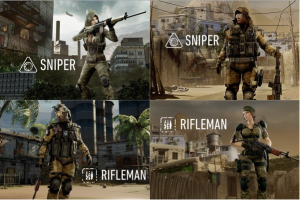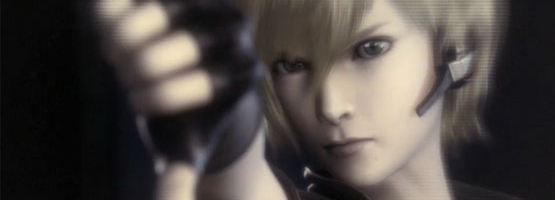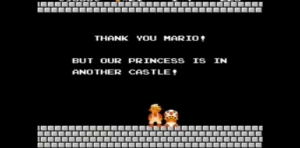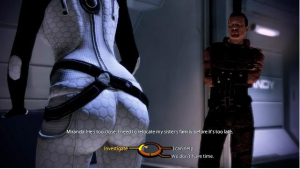It’s time to stir up the hornet’s nest yet again. As the debate continues over sexualized female character designs, there is one criticism and one defense used by both sides: One dimensional characters.
Every critic of poor female character design focus on how women in games are barely defined characters meant to be rescued or ogled over. And the defenders focus on the fact that because the men are just as poorly written, that things are fine. For today’s post, I’m going to tread the line and explain why in my opinion this is a flimsy defense for both sides.
Filling in the Plot Holes:
When discussing storytelling in video games, one of the first things you have to do is to split your discussion between older titles (Nintendo 64 era and earlier) and modern games (Playstation two/Dreamcast to modern).
The reason is that the industry made a fundamental shift in design and storytelling around the last decade as games became mainstream. Suddenly, designers realized that there was more to video games than just running around saving princesses and shooting aliens.
We saw design as a whole became more standardized and accessible, while storytelling became more cinematic. But we are getting ahead of ourselves.
In Anita Sarkessian’s first tropes vs. women video, she brought up the damsel in distress trope as an example of poor character design against women and her video focused heavily on the Super Mario games and other classic 2D series.
There are two big issues with citing classic games as any kind of attack, denouncement or criticism of women. First is the defense that we talked about at the start: That the men are as poorly defined.
If you look at any male hero in the 16 bit era and earlier (with exception to RPGs,) their personality could be defined in one sentence:” good guy wants to save the girl.” That’s it, no deeper meanings, no internal conflict, just he’s there to save the girlfriend/wife/princess/queen etc. And the women in these games are just as thinly written — The bad guy has them trapped until the man comes to save them.
While the women in these games barely said or did anything to define themselves as actual characters, the men were simply puppets used by the player to experience the gameplay. The only real character development in these games was usually the end scene where the reunited couple kissed before the credits roll.
There was barely any attempt at plot or storytelling as most video games were built as one-offs and not meant to become series.
So there was no reason to create any established plotlines or worlds as only a few games out of the hundreds that were released, had sequels made for them.
A stark difference to today where major publishers only want games that can become franchises.
Gameplay is also the second issue with holding classic games as targeting women character design. As we’ve talked about, classic games barely featured any storytelling and the plots they had were just an excuse for the gameplay.
Anita’s example of Super Mario Bros 2 proves this point, as Nintendo basically copied the gameplay wholesale from a Japanese game and put Mario and friends in it and called it Super Mario Bros 2. Designers weren’t caring about plot and character development for most of the 80s and 90s; it was all just a thin excuse to explain why someone is fighting monsters or saving the day.
This is why I find any attempt to criticize Nintendo for their storytelling to be a bit off, as Nintendo to this day has always been a gameplay focused company. I’ve yet to see a Nintendo developed game attempt to tell an engaging story beyond: Someone has to save the day.
Could Nintendo make a well crafted story and elevate their games further? Possibly, and I would love to see them do that. However Nintendo has proven time and time again that their focus is on gameplay.
Now you may be wondering at this point as to why I haven’t brought up modern era games yet. The reason is that this is where the defense of one dimensional character design begins to wear thin.
Not So Equally Designed:
As video game production values improved, game makers began to flesh out (no pun intended) characters and storytelling as designers were aiming for cinematic quality in their games.
As developers began to take a closer look at their games, this is when we began to see the split in terms of gender equality in games. And to me, there are several red flags that are raised when people try to use poor character design as a catch all defense against misogynistic behavior.
First is the use of “male gaze”, or when a designer purposely writes and shows the game from only a male perspective.
Some examples: Gratuitous shots of women, all the women are defined as poor tropes (the dumb blonde, the sex object and so on.), using the damsel in distress trope with a fully realized male (or female) character and so on.
Even if you use a poorly defined male character, that doesn’t give you a free pass with a sexualized female character. For instance, in the Splatterhouse remake, both main characters were barely defined. However, the developers thought it would be cute that you could find photographs hidden in each level of the female posing topless in a variety of poses.
The next red flag is the classic defense of trying to compare extreme masculinity to sexualized women. Again, it needs to be pointed out that the game is still being designed to appeal to men. The sexualized women are meant to be eye candy to the men, while the muscular men are meant to appeal to the power fantasy of men.
Now of course some defenders will say that there are women out there who find hyper masculinity attractive. However, that is the case of the exception rather than the norm and not the original intent of the designer.
So while the Soul Cailbur series have crazy back stories for all their characters along with over the top costumes, it still doesn’t rationalize the women having breasts bigger than their heads.
While Dragon’s Crown may not be the best example of gender equality in terms of setting, it did get one thing right: An equal design sensibility for both genders in terms of the main cast. Every main character with exception to the wizard and the archer were hyper sexualized based on the secondary sex characteristics of their respective gender.

Having barely defined male characters is not an excuse to have sexualized female characters in this day and age.
However, while that is a positive example in one area, it’s a failure in another. The game was more focused on pandering to the male demographic with the design of the female side characters.
Simply put, outside of retro aimed games there isn’t an excuse for one dimensional characters regardless of gender.
With the growth of technology and the creativity in regards to game design, trying to tell a story with poor character design is an example of lazy writing.
For all the work that goes into graphics engines and focus testing and so on, storytelling feels like it’s evolving at a glacier pace compared to the other parts of game development. Now, this isn’t a call to create nothing but ugly characters or nothing but super models, but for a higher quality of character development.
And of course not every game has to have a story on par with Lord of The Rings or writing like Shakespeare. If the industry can begin to move away from one dimensional characters, regardless of gender would be a step in the right direction.
There is a major difference between trying to appeal to the male demographic vs. completely pandering to it. With the former, given the right design decisions and storytelling you can have examples of strong female characters alongside the male.
Or the game is built in a way that it can appeal to women without looking down at them or insulting them. With the latter, there is simply no room or concession for anyone other than the specific demographic. And expect people who aren’t part of that demographic to feel uncomfortable while playing.
I’m tired of seeing poorly written women as much as I’m tired of men written the same way. Why either gender has to be dumb down for the good of a game’s story is beyond me. Especially if the Game industry wants to be taken seriously as art.




